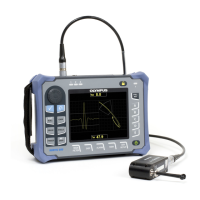DMTA-10040-01EN, Rev. E, February 2018
Using the Instrument 257
Figure 5‑189 An RFT probe
This application uses a probe adaptor configured for differential mode. The
differential configuration subtracts the signals obtained by both receiving coils and, as
such, is ideal for detecting smaller discontinuities such as pitting, but also shorter
discontinuities such as wear under a support (see Figure 5-190 on page 257). The
differential configuration, however, cannot be used to detect longer or gradual
discontinuities for the simple reason that the discontinuity signal is “subtracted”
(diminished) and therefore not useful. To detect longer or gradual discontinuities,
absolute mode must be used.
Figure 5‑190 An example of an RFT differential signal response
Dual exciter probes (such as TRX series Olympus probes) are recommended for
differential configuration because these types of probes provide a clearer and cleaner
response to smaller, localized discontinuities (see Figure 5-191 on page 258). Single
exciter probes (such as TRS series Olympus probes) can also be used; however, they
are generally outperformed by dual exciter probes for pitting detection.
Transition
zone
Magnetic flux line
Indirect or remote field
Simplified magnetic flux path
Exciter coil
Direct field
Pickup coil, absolute and differential

